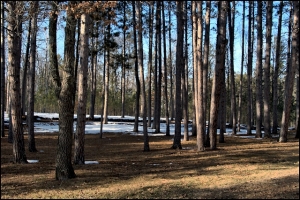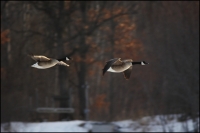Finally! This is the time of year that the weather will finally begin breaking here in central Minnesota. The urge to get out with the camera is becoming too strong to ignore.
I started to look through some of my past year’s photos to see where I’d been and what I’d shot, and suddenly came to the realization that it’s time for a paradigm shift in how I go about searching for new shots. Rather than just going ‘out’ it’s time to become a little more structured. And if this structure helps to improve my chances of getting a decent shot, then the planning is worth it. So here are some thoughts and ideas to think about:
Step #1: Your old ‘bad’ photos are the best photos you have ever taken. Review them often.
(If you don’t have any, then go take some. Of anything.) The photo to the right is just a representative shot of what conditions look like on a ‘big cloud’ day. But a different location with better foreground features could make this into a great shot. Look at your old shots with a new eye. How can you change things to make them better? If photography is your hobby and not your profession, you are probably limited to the amount of time and other resources you can spend. And this is discouraging to some. We all wish we lived in a more ‘photogenic’ part of the country. But by thinking through your projects and re-evaluating what you see and have seen, you can change your ‘snapshots’ into something you’ll be proud to hang on your wall.Step #2: Photos are made from light. Plan ahead and be prepared for change. No matter if you are going out for a day or an hour, target subjects that will work with the available light and current weather or the with the lighting and/or tripod you can
take with you. By doing a little planning in advance, you can increase your chances of getting a good shot. And if possible, have a backup plan if conditions change. It seems they always do.Step #2.5: Take 1,000 photos a day. What? 1,000 shots a day? Well maybe I am exaggerating a little here. But the idea is that no matter where you go, there are great shots that you could have taken if the light was different, or the weather was different, or it was a different time of year or time of day. So snap a bunch of shots anyway no matter what else you do. Change your camera to the lowest jpg setting if you don’t want to use up your card or disk space. Just take snapshots, lots of them. These photos will give you loads of ideas of what could be done with the subject if you went back at a different time. Here is an example shot of a tree. It’s a nice tree but the photo is just one of the shots I took one day on a hike. But as you can see from the other examples of the same tree below, it can take on a lot of different looks.
Step #3: Prepare a list of projects in advance of your outings so you can take advantage of any weather condition. I have been working more and more with the idea of planning trips or photo treks with
specific projects in mind. The specific items to consider are:- Time of year.
- Amount of time available. (Going for two hours or two days?)
- Weather conditions. (Which usually means how much and what kind of light will be available)
There have been many times in the past when I have had free time early in the morning or in the evening or on a weekend when I would just take off on a ‘photo’ trip. Over the past years I have put on many hundreds (really thousands) of miles and been to many places. But I now realize that I passed a tremendous amount of good photo opportunities and really don’t remember many of the things that I saw. And I had a camera with me! Now I really wish I would have just flipped the setting to jpg-small and continually snapped away at whatever I saw. The shots would not have had to be ‘good’. But having that record of where I’d been and all the other miscellaneous things I saw would now give me a tremendous amount of material to use to plan new effective outings and an excellent amount of ‘idea-generators’.
Step #4: A pencil is sometimes more valuable than a camera. Take a notebook and pencil along whenever you go out. Keep notes on thoughts you
have even if you haven’t found that ‘perfect’ shot to take. Make notes about subjects (things) you see that you think might make a great shot, but need to be found in a different context or at a different time. When you are out with your camera you are at your most creative level. You are thinking about what you see and what you can shoot. Jot down notes about these ideas and when you get home review them. Add your ideas to your master list of projects that you want to work on. Then after you review and update your projects, make a targeted list of what you want to do on your next outing. With a little forethought you can be ready to have a productive and much more enjoyable time on your next excursion if you have a plan ready. You have really increased your odds of coming back with a great shot.Step #5: If you have a GPS, turn it on. If you don’t, get some maps of the areas you plan to be shooting in or print them out
from the Web. When you see something that would make a great shot mark a waypoint on your GPS or mark it on the map. I have used this technique to good advantage in the past. If I’m out in the summer and see a spot that I think would make a great shot in the winter, I mark it. I have been to many of Minnesota’s State Parks and have marked interesting spots with a note about what and when might make it a good spot to revisit. And now when I’m out, I can check GPS and look at the list of nearest waypoints to see if there is something interesting close by that I otherwise would have forgotten about.Step #6: Expand your workflow to include what really counts. (I know, I know. There are only supposed to be 5 steps.) There is a measureless amount of information on the Web on the best way to handle your digital workflow. People spend hours writing and reading about how to best manage their photos and files on their computers and what programs to use to convert their digital data into viewable or printable photos. This has to be important to professionals, and is important to pro-amateurs as well. But after a number of years of shooting digital and taking tens of thousands of shots, I am becoming convinced that the planning and work you do when you are not in front of the computer is the most important. When I first ventured into digital, I spent many, many hours processing the photos I had taken. There is a lot you can do with computer workflow, but as they say, you can’t make a silk purse from a sow’s ear. Personally I know that if I would have spent the bulk of those hours in thinking about the big picture of what I was trying to accomplish rather than what exact radius and threshold setting I should use for the unsharp mask for a shot I would have many more pleasing and enjoyable photos.
Learn all you can about photography and photo techniques, and all you can about digital workflow and processing. But also stop and step back and look at it all in context. Look at your old shots and ask yourself ‘why do I like this one?’ and ‘what could I have done to improve this?’. I guarantee you’ll come up with effective and exciting ideas about what you will be doing the next time you pick up your camera.





Leave a Comment